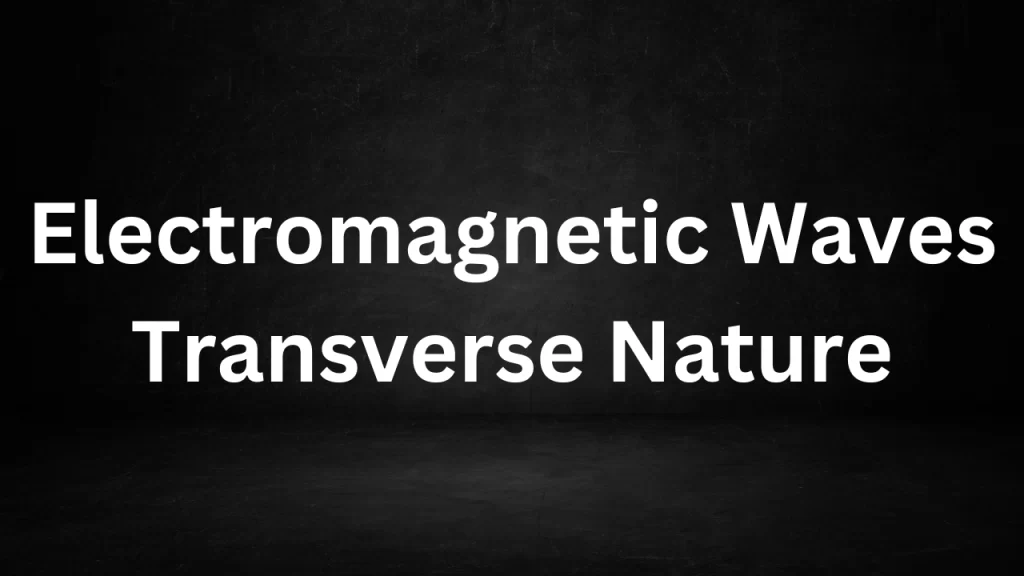Tag: transverse electric waves
Electromagnetic Waves Transverse Nature
Electromagnetic Waves Transverse Nature: Electromagnetic waves are a fundamental aspect of the electromagnetic spectrum, encompassing phenomena such as radio waves, microwaves, visible light, and more.
One of the distinguishing characteristics of electromagnetic waves is their transverse nature, which sets them apart from other types of waves.

Transverse Waves: A Quick Overview
Transverse waves are a type of wave in which the oscillations of the wave propagate perpendicular to the direction of the wave’s motion. This means that while the wave itself travels in one direction, the individual particles or fields oscillate at right angles to that direction.
Understanding Electromagnetic Waves:
- Electromagnetic Field Oscillations: Electromagnetic waves are composed of electric and magnetic fields that oscillate as the wave propagates. These fields are perpendicular to each other and to the direction of wave motion.
- Perpendicular Oscillations: In an electromagnetic wave, the electric field oscillates in one plane, while the magnetic field oscillates in a plane perpendicular to the electric field. Both fields are orthogonal to the direction of wave propagation.
- Light as an Example: Visible light, which is a form of electromagnetic wave, demonstrates this transverse nature. The oscillating electric and magnetic fields give rise to the characteristic properties of light, such as polarization and interference.
Key Features of Transverse Nature:
- Polarization: The transverse nature of electromagnetic waves allows for polarization. Polarization refers to the orientation of the oscillations of the electric and magnetic fields in a specific direction perpendicular to the wave’s motion.
- Propagation in Empty Space: Electromagnetic waves can propagate through a vacuum, as they do not require a medium for their transmission. This characteristic is a result of their transverse nature.
- Interference and Diffraction: The transverse nature of electromagnetic waves enables them to exhibit interference and diffraction patterns, which are phenomena observed when waves interact with each other or encounter obstacles.
Electromagnetic Waves and Transverse Motion:
- Electric and Magnetic Fields: Electromagnetic waves consist of varying electric and magnetic fields. As the wave travels, these fields oscillate in directions perpendicular to each other and to the direction of the wave.
- Perpendicular Oscillations: The electric field oscillates in a plane perpendicular to the magnetic field, and both are at right angles to the direction of wave propagation. This unique oscillation pattern gives electromagnetic waves their transverse nature.
- Visible Light Example: Consider visible light, a form of electromagnetic wave. The varying electric and magnetic fields give rise to the different colors and properties of light. The transverse oscillations are responsible for phenomena like polarization and color dispersion.
Significance and Characteristics:
- Polarization: The transverse nature allows electromagnetic waves to be polarized. Polarization refers to the alignment of the oscillations in a specific direction. Polarized sunglasses, for instance, filter out certain orientations of light waves to reduce glare.
- Propagation in a Vacuum: Electromagnetic waves can travel through a vacuum, devoid of any material medium. This is due to their transverse nature, which doesn’t require particles to oscillate in the wave’s direction.
- Interference and Diffraction: Transverse waves exhibit interference and diffraction patterns when they interact with each other or encounter obstacles. These patterns result from the superposition of waves with different phases and amplitudes.
Applications:
The transverse nature of electromagnetic waves is at the core of various technological applications, including wireless communication, radio broadcasting, television transmission, and fiber-optic communication. Understanding how these waves oscillate perpendicular to their motion helps engineers and scientists harness their properties for a wide range of purposes.
In summary, the transverse nature of electromagnetic waves is a defining characteristic that governs their behavior, propagation, and applications. This unique feature plays a pivotal role in our ability to communicate, observe the universe, and develop technologies that shape modern society.
Read More
- Kinetic Gas Equation Derivation
- Difference Between KVA And KW
- Difference Between LCD And LED
- Difference Between In Physics
Frequently Asked Question (FAQs)
What does “transverse nature” mean in the context of electromagnetic waves?
In the context of electromagnetic waves, “transverse nature” refers to the perpendicular oscillations of electric and magnetic fields. These oscillations occur at right angles to the direction in which the wave is traveling.
How do the electric and magnetic fields oscillate in electromagnetic waves?
The electric and magnetic fields in electromagnetic waves oscillate perpendicular to each other and to the direction of wave propagation. This perpendicular oscillation gives rise to the unique characteristics of electromagnetic waves.
What is the significance of the transverse nature of electromagnetic waves?
The transverse nature of electromagnetic wave is responsible for various phenomena and applications, such as polarization, interference, diffraction, and the ability to propagate through a vacuum.
How does the transverse nature allow electromagnetic waves to propagate through a vacuum?
Unlike other types of wave that require a medium for propagation, the transverse nature of electromagnetic wave enables them to travel through a vacuum because they don’t rely on the movement of particles for transmission.
What is polarization in the context of transverse electromagnetic waves?
Polarization refers to the alignment of the oscillations of the electric and magnetic fields in a specific direction perpendicular to the wave’s motion. This property has applications in areas like optics and communication.